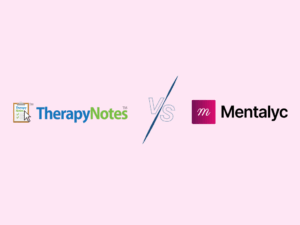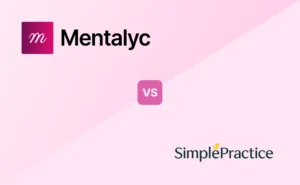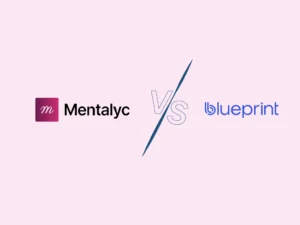As occupational therapists and healthcare professionals, we know how important thorough documentationis. Not only does it protect us legally, but it allows us to monitor our clients’ progress over time and collaborate with other providers.
Among the various notes we write, occupational notes seem to get the least love 🙁 They’re often an afterthought we scribble down between sessions rather than an opportunity to showcase our skills.
But what if we approached occupational notes not as a chore, but as a chance to flex our creative muscles? An occupational note doesn’t need to be boring! It can be a vivid portrait of the client that brings their experience back to life. Our notes have the power to spark insight and discussion among colleagues. Why not make them as engaging as the clients we work with?
As a practitioner, I’ve found that writing creatively actually enhances my ability to understand and empathize with clients. It’s like mental meditation, replaying our sessions while choosing an evocative yet clinically precise language. As such, with practice, occupational notes can become a mini form of art: concise stories that capture growth in each person who walks through our doors.
In this post, I’ll offer some tips I’ve learned for writing occupational notes with style. I’ll also share examples from my notes, edited for confidentiality. My hope is that we can work toward a future where notes become a reflection of our passion for this work rather than an afterthought. With some creativity, even paperwork can be rewarding!
Let’s Start: What is Occupational Therapy?
Are you finding it more challenging to perform everyday tasks due to a recent wrist injury? Are you a parent who’s concerned about his child’s ability to interact with peers due to autism or a disability? Well, we’ve all had those moments where an injury or change in our abilities makes even the simplest tasks more difficult than they used to be. Getting dressed, cooking a meal, driving to work – the activities we did without thinking can suddenly become major challenges when our bodies aren’t working the way they used to. But you don’t have to let minor injuries or disabilities sideline you for long. That’s where occupational therapy comes in.
As an occupational therapist, nothing is more rewarding than seeing the smile on a client’s face when they accomplish a goal they once doubted was possible. Just last week, I was working with an elderly woman who had lost some mobility after a fall. One of her main goals was being able to prepare simple meals again so she wouldn’t have to rely on others. After successfully helping her to prepare a grilled cheese sandwich without any assistance, the look of pride and joy was absolutely beautiful. In that moment, I was reminded of why I love this career – helping people find purpose and independence through daily activities is so meaningful.
Occupational therapists’ work involves taking a holistic approach to understand each individual and what truly matters most to them. Rather than just focusing on deficits, we like to ask questions like “What brings you joy in life?” or “What hobbies do you hope to get back to?”. This helps us design personalized plans that incorporate meaningful goals. As OTs, we have to get to know our clients as whole human beings to develop interventions tailored to their unique needs, values, and lifestyles.
The diversity of clients and conditions we treat is what keeps this work endlessly fascinating. On any given day, we could be assisting a child with special needs (autism for example) learn essential self-care routines to thrive in school and social situations, helping an injured athlete slowly progress their rehabilitation exercises to return to sports, or adapting household tasks for someone with arthritis so they can live independently longer. But no matter the presenting problem, our approach follows the same principles – carefully observing each person’s abilities, habits, roles and environment to build interventions centered around improving their quality of life.
Ok, Why Bother About Notes?
My friends, as occupational therapists, we know all too well how important clear documentation is to our work. Not only does it protect our licenses, but thorough notes allow for continuity of care as clients transition between settings or providers.
For starters, remember why we’re writing – to demonstrate each person’s unique needs, goals, and treatment journey over time.
A colleague of mine describes sessions like chapters in a book. I loved her metaphor and plan to borrow it. Instead of drab random notes, we should strive to craft narrative case stories. Weaving in clients’ own words helps their voices come through too.
As per regulations, occupational therapists are obligated to record their interactions with clients. To meet this requirement, they commonly employ SOAP notes, which stands for subjective, objective, assessment, and plan. These notes serve as a standardized format for medical documentation, enabling OTs to systematically document their client appointments. By using SOAP notes, OTs enhance their capacity to deliver top-notch treatment in a quantifiable manner.
Documentation in the Subjective Section
Let’s kick things off with the Subjective section. This one gives us insight straight from the source – our patients themselves! It’s where we capture their story in their own words. Starting with the chief complaint, we want to know exactly what brought them in today. Then we dive into their history, learning more about how long they’ve dealt with this and any factors that make it better or worse. Beyond just medical issues, don’t forget about lifestyle habits and home situation too – those impact health as well.
In brief, this section of the SOAP note should include:
- Subjective information about the client’s past relevant history to help define the problem, for example “I’ve lived by myself for the past year”.
- Pertinent client quotes should be included, such as “I want to be more independent”.
- The client’s complaints should be documented, for example, “I can’t, I’m in pain”.
- The client’s own perspective of their progress should be included, e.g., “I think I have gone backwards.”
- Reported pain scores, e.g., 6/10 pain, should be included as it is subjective. Relevant pain signs can be mentioned as observations in the objective section.
- It is acceptable to use direct quotations or paraphrases, for example, “The client reported that…”
- Answers or measurements from screens or assessments should not be included.
For instance, an occupational therapist conducting transport training for a person with an acquired brain injury (ABI) may note:
John, a 23-year-old male, is currently engaged in physical and cognitive rehabilitation following an ABI that occurred approximately six months ago. As part of his rehabilitation process, he has recently commenced transport training in order to achieve his objective of independently catching the bus. Prior to their session, John was assigned the task of planning his bus route online, as he intends to travel to a friend’s house later this week. Unfortunately, John encountered significant difficulties with this assignment. He arrived at his session feeling discouraged mentioning that he is struggling with his homework.
Documentation in the Objective Section
Once we understand the full picture, the Objective section allows us to add our observations. When assessing physically, be thorough yet objective. Note any concerning exam findings, plus results from tests like x-rays. Functional abilities are also key – can they care for themselves? How’s mobility? Compare to past records too.
When drafting your note consider the following:
- Objective information in SOAP notes can come from assessments, observations, screenings, and evaluations conducted by you or other staff members or through the use of instruments.
- It should include facts and data related to the client’s condition.
- Examples of objective information include range of motion (ROM), strength, facial expressions, etc.
- Both function and dysfunction should be documented, including deficits and strengths.
- The objective information should be relevant to the client’s problem and goals.
- Avoid including opinions, insights, interpretations, or making connections in the objective section. It should be objective and reproducible by other therapists.
Building upon the previous example, documentation in the Objective section could include the following:
During the session, the occupational therapist observed that John encountered challenges in maintaining focus on the task of planning the bus route and had difficulty differentiating between the bus routes that led to his friend’s address.
Documentation in the Assessment Section
With all that input, we arrive at the Assessment.
Now it’s time to put on our healthcare detective hat! Analyze the clues and make your best determination of what’s going on. This section justifies our clinical judgment. It also starts the handoff to treatment by wrapping up the situation in one summary paragraph.
Briefly, the assessment section aims to:
- Interpret and/or reassess the subjective and objective information.
- Highlight the client’s response to treatment, including their attitudes and cooperation.
- Document any changes in the client’s condition and progress, whether it’s improvement or decline.
- Provide a summary of the client’s needs, such as equipment requirements.
- Provide suggestions for discharge plans and referrals.
Based on observations, John demonstrates ongoing cognitive impairment characterized by significant executive dysfunction and impaired concentration. It is likely that he will need further one-on-one support to achieve the goal of utilizing public transport autonomously.
And finally, the Plan
This is where the real magic happens! This is where we translate our assessment into a clear roadmap.
Lay out the specific therapies, follow ups, or lifestyle changes you believe will help. But most of all, put the patient at the center. Craft the plan carefully taking their needs and preferences into account. Hand them a clear schedule to keep them invested in their own care journey.
The occupational therapist will address the necessity of additional one-on-one support for John during the team meeting scheduled for tomorrow. The therapist will request the inclusion of an assistant to implement a time-limited supported transport training program. John has expressed his agreement with this proposed plan.
SOAP Note Examples and Templates for Occupational Therapists
SOAP Note Example for a Pediatric Client:
Subjective:
- The client arrived at the session accompanied by their parents.
- The parents reported that the client has been responding positively to their sensory diet at home.
- The client further expressed a positive attitude towards the session.
Objective:
- The client successfully completed activities of daily living (ADL) tasks, including tying shoes and washing hands, with moderate verbal cues for sequencing.
- Assistance was required for the client to zip up a jacket due to decreased fine motor coordination.
Assessment:
The client demonstrated improved frustration tolerance during the session, as evidenced by persevering with the challenging task of zipping up the jacket without quitting or becoming frustrated.
Plan:
- The client will continue practicing ADL tasks independently at home.
- The current plan of care will be maintained to enhance the client’s independence in ADLs and self-regulation.
SOAP Note Example for a Client in a Nursing Facility:
Subjective:
The client was awake upon the therapist’s arrival but reported not sleeping well and being awake for three hours. Despite feeling tired, the client expressed willingness to participate in the session, actively requesting to work on tooth brushing this time.
Objective:
The therapist provided the client with a toothbrush and toothpaste. The client required moderate assistance due to decreased fine motor coordination and strength. With moderate verbal cues, the client successfully brushed their teeth, demonstrating improved sequencing skills.
Assessment:
Despite feeling tired, the client actively engaged in the occupational therapy session. The client displayed progress, requiring only moderate assistance.
Plan:
The current plan of care will be continued to enhance the client’s independence in Activities of Daily Living (ADLs), with a particular emphasis on readiness for their expected return to their family home in one month.
9 Tips by Mentalyc for Writing Effective Occupational Therapy SOAP Notes
Promptness is Key
Ensure you write SOAP notes immediately after each client session to maintain accuracy and prevent missing important details. Delaying note-taking can lead to forgetting crucial information about the client’s condition and treatment plans.
Quality Trumps Quantity
Focus on writing concise and clear notes rather than lengthy ones. Provide relevant information about the client’s present condition, including range of motion, muscular strength, treatment recommendations, and expected outcomes.
Customize Templates
Use personalized SOAP note templates tailored to your practice’s specific needs. Custom templates save time and promote consistency.
Include Subjective Details
When writing the subjective section of SOAP notes, cover essential information such as medical history, current medications, allergies, lifestyle, ability to perform tasks, goals, and expectations.
Include Objective Details
The objective part of SOAP notes should encompass vitals, range of motion, balance, strength, coordination, physical exam findings, functional testing techniques, and relevant imaging or diagnostic readings.
Include Assessment Details
Cover the diagnosis, OT’s assessment of the client’s condition and outlook, objectives, goals, and expected outcomes.
Include Treatment Plan Details
Thoroughly outline the recommended therapies, intervention frequency and duration, referrals, follow-up timelines, and collaboration with other medical experts in the treatment plan section.
Listen Attentively to Clients
Active listening is crucial for taking comprehensive SOAP notes. Document important statements made by clients, even if they seem unrelated to the current condition being treated. Clients’ concerns provide valuable insights.
Maintain Legibility
Opt for electronic note-taking to ensure readability and comprehension by all users. Legible notes contribute to continuity of care, reduce miscommunication, and enhance client safety and treatment effectiveness
References
Occupational Therapy Practice Framework: Domain and Process (4th ed.). (2020). American Journal of Occupational Therapy, 74(Suppl. 2), 7412410010p1-7412410010p73. https://doi.org/10.5014/ajot.2020.74S2001
Why other mental health professionals love Mentalyc

“It’s so quick and easy to do notes now … I used to stay late two hours to finish my notes. Now it’s a breeze.”
Licensed Professional Counselor

“By the end of the day, usually by the end of the session, I have my documentation done. I have a thorough, comprehensive note … It’s just saving me hours every week.”
CDCII

“A lot of my clients love the functionality where I can send them a summary of what we addressed during the session, and they find it very helpful and enlightening.”
Therapist

“Having Mentalyc take away some of the work from me has allowed me to be more present when I’m in session with clients … it took a lot of pressure off.”
LPC







